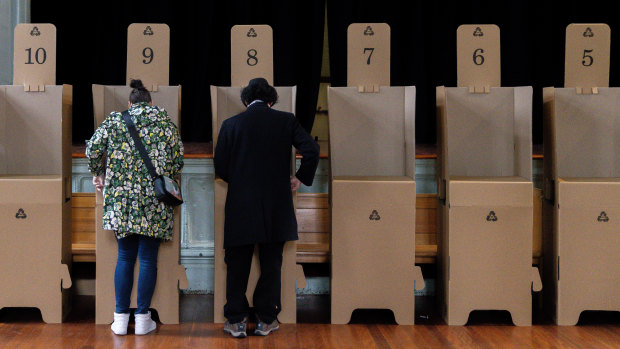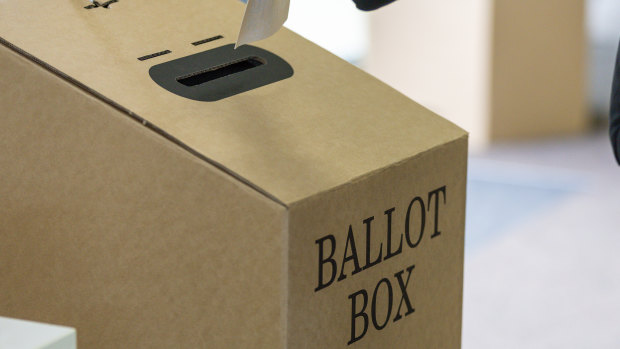This was published 2 years ago
Opinion
The Constitution was designed to be hard to change. It was not meant to be impossible
Anne Twomey
Constitutional expertWhat hope is there for future referendums in Australia at the federal level following on from Saturday’s outcome? Very little.
From its first adoption in Australia, the referendum was dubbed the “People’s Veto”. While politicians kept for themselves the power to initiate a referendum proposal, the role of the people was to put a brake on any partisan excesses or attempts by politicians to aggrandise their power.

It’s been almost half a century since a referendum has passed in Australia.Credit: Getty
It wasn’t long before politicians found this frustrating. In 1915, the Fisher Labor government tried to turn things around by introducing compulsory voting for the referendums it intended to hold later that year. It simultaneously introduced a Yes/No pamphlet to ensure that the unwilling voters would be well-informed. According to Billy Hughes, the pamphlet was to be “put in an impersonal, reasonable and judicial way”.
The pamphlet, however, immediately became a tool for spreading confusion, which increased the fear of change and the likelihood of electors voting to stick with the status quo.
The legacy of compulsory voting in referendums is contested. On the one hand, it probably makes referendums harder to win, with those who are uninterested and disengaged most likely to default to a No vote. The master-stroke of the same-sex marriage plebiscite was to make it a voluntary postal vote.
On the other hand, compulsory voting provides a moderating force, preventing the outcome from being dominated by those on the extremes and allowing the campaign to focus on issues rather than “getting out the vote”. It also performs an important civic education function, nudging people to inform themselves and engage with the political system. Compulsory voting is therefore a price worth paying.
When the framers of the Australian Constitution were contemplating the merits of the referendum, there was also a push to adopt it in the United Kingdom to resolve contentious issues such as Irish home rule. Lord Curzon, Viceroy of India, opposed it, arguing that while a referendum might be appropriate for a simple question, it “becomes an absurd and delusive method when the question is one of great complexity … crammed with clauses and bristling with disputable propositions”. The idea was dropped.
In Australia, however, Lord Curzon’s words have a haunting prescience. They well describe the doomed republic referendum of 1999, which was necessarily crammed with clauses and bristling with disputable propositions.

Even the Voice referendum, with simple, short and clear wording, could still be deluged with disputable propositions.Credit: Asanka Ratnayake
Even the Voice referendum, with simple, short and clear wording, could still be deluged with disputable propositions, most of which concerned what it did not say. In the absence of any words in the amendment that imposed an obligation on the government to consult the Voice or give effect to its representations, those opposed to the referendum argued the High Court could interpret its words to mean what they did not say, or indeed anything at all.
This argument, that you cannot make a change to the Constitution because it may one day be interpreted by a court to mean the opposite, is effectively an argument against ever changing the Constitution. On this basis, every amendment is “legally risky” and all change is dangerous. It is an argument that misconceives the role of the courts and undermines trust in the judiciary.
Another claim, which sets an impossible bar to meet, is that voters must be provided, before a referendum, with the “detail” of how any power proposed to be conferred on parliament or the executive government will be exercised in the future. Not even Nostradamus could satisfy that demand. It would wipe out most constitutional reforms.
While the Constitution was intended to be hard to change, it was not meant to be impossible. Referendums were held frequently in the early years after federation. But referendum-scarred governments became increasingly reluctant to put constitutional change to the people as the defeats, both rational and irrational, mounted up. Menzies described it as a “labour of Hercules” to achieve constitutional reform.
Until Saturday, we had not had a referendum for 24 years, and since Saturday, no successful referendum for 45 years. They have become sport for oppositions to gain political points and a petri dish for propagating misinformation and conspiracy theories. In a hyper-partisan and post-truth world, the prospects of referendum success now depend more than ever on an elusive spirit of bipartisan cooperation.
There is a price to pay if the Constitution becomes unamendable. It undermines the sovereignty of the Australian people if they cease to exercise their responsibility of voting on constitutional change and poses a risk to the longevity of the Constitution.
Every Constitution needs occasional review and updating to ensure it maintains public support and can properly function. Freezing it in time only makes it brittle and risks it shattering when under pressure.
While those who oppose constitutional reforms imagine great risk in any change, they remain blind to the greater risk of an unamendable Constitution.
Anne Twomey is a Professor Emerita at the University of Sydney and was a member of the Constitutional Expert Group that advised on the Voice referendum.
The Opinion newsletter is a weekly wrap of views that will challenge, champion and inform your own. Sign up here.